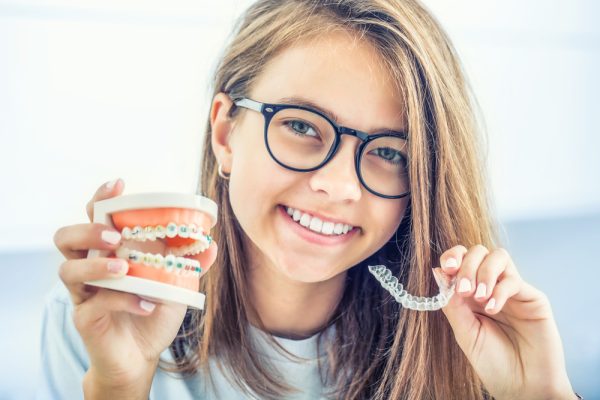Choosing the Right Orthodontic Treatment
Deciding to enhance your dental alignment is a significant step towards achieving not only a stunning smile but also improved oral health and self-confidence. Amidst the myriad of orthodontic options available, selecting the perfect one tailored to your unique needs can seem like a daunting task.
At your consultation with our Wasilla dentist, he’ll evaluate your oral health and recommend the best orthodontic treatment option for your needs. While we do provide Invisalign at Northwind Dental, we may refer you to an orthodontist if traditional braces are the best course of treatment.

Alternatives to Invisalign Treatment
Traditional Braces
Traditional braces are one of the most common orthodontic treatments. They consist of brackets glued to the teeth and connected by wires. An orthodontist adjusts these wires over time to gradually straighten the teeth. While they may not be the most aesthetically pleasing option, they’re effective for correcting a variety of dental issues.
Lingual Braces
Lingual braces are similar to traditional braces, but the brackets and wires are attached to the back of the teeth rather than the front. This makes them virtually invisible from the front, but they can be more difficult to clean and adjust than traditional braces.
Ceramic Braces
Ceramic braces are a type of orthodontic appliance used to straighten and align teeth, similar to traditional metal braces. The primary difference is the material from which they’re made. Ceramic braces are made from a clear or tooth-colored ceramic material, which makes them less noticeable than their metal counterparts.
The brackets of ceramic braces are bonded to the front of the teeth and are connected by a wire. This wire is gradually tightened over time, applying pressure to the teeth and guiding them into the desired positions.
Self-Ligating Braces
Self-ligating braces are similar to traditional braces, but they use a special clip or bracket that holds the wire in place, eliminating the need for elastic bands. This can make them more comfortable and reduce the number of appointments needed for adjustments.
Retainers
While retainers aren’t typically used for severe orthodontic issues, they’re recommended after treatment. Their primary function is to hold teeth in their current positions.
Which Treatment is Best for You?
When deciding on orthodontic treatment, you and your orthodontist will discuss the following:
- Effectiveness: The most important factor is whether the treatment will effectively correct your dental issues. Dr. Dawson can evaluate your teeth and recommend the best alignment method for your specific needs.
- Aesthetics: Invisalign and lingual braces are more aesthetically pleasing than traditional braces but may not be as effective for correcting severe dental issues. Consider your personal preferences and lifestyle when choosing a treatment.
- Cost: Dental alignment treatments can vary in cost, so consider your budget when making a decision. Your dental insurance may cover some or all of the costs of certain devices, so be sure to check with your provider.
- Convenience: Invisalign can be removed for eating and cleaning, making them a convenient option for many patients. However, they do require a certain level of responsibility and commitment to wearing them consistently.

Frequently Asked Questions
The length of treatment can vary greatly depending on the severity of your dental issues and the type of alignment method. Traditional braces typically take 18 to 24 months to straighten teeth, but more complex cases may require longer treatment. On the other hand, Invisalign can take anywhere from six to 18 months, depending on the severity of your dental issues and how consistently you wear them.
It’s normal to experience some discomfort or soreness after getting braces or starting clear aligner treatment. This discomfort usually subsides within a few days, but over-the-counter pain relievers and cold compresses can help alleviate any discomfort you may feel.
With traditional braces, there are certain foods that you will need to avoid to prevent damaging the brackets and wires. For example, hard or sticky foods like popcorn, chewing gum, or candy can all pose a risk to your braces.
Invisalign, on the other hand, can be removed for eating and cleaning. This means that you can eat whatever you want during treatment as long as you remove your aligners beforehand.
Transform Your Smile Today!
Don’t let misaligned teeth hold you back from living your best life. The confidence that comes with a beautiful, healthy smile is priceless, and Northwind Dental is here to help you achieve that.
Take the first step towards the smile of your dreams by scheduling a consultation with Dr. Dawson. Let us help you regain your confidence and transform your life with a beautiful, healthy smile.
